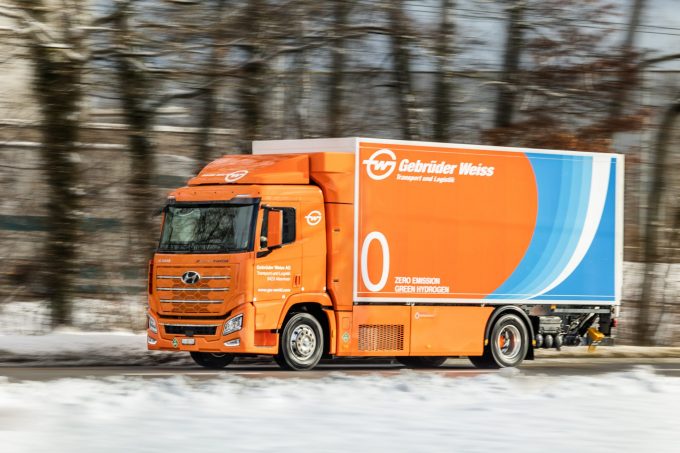NOCC adds third ‘ammonia-ready’ PCTC newbuild orderbook
Norwegian Car Carriers (NOCC) has added a third ‘ammonia-ready’ 7,000ceu LNG-powered ship to its two-vessel, ...
TFII: SOLID AS USUALMAERSK: WEAKENINGF: FALLING OFF A CLIFFAAPL: 'BOTTLENECK IN MAINLAND CHINA'AAPL: CHINA TRENDSDHL: GROWTH CAPEXR: ANOTHER SOLID DELIVERYMFT: HERE COMES THE FALLDSV: LOOK AT SCHENKER PERFORMANCEUPS: A WAVE OF DOWNGRADES DSV: BARGAIN BINKNX: EARNINGS OUTODFL: RISING AND FALLING AND THEN RISING
TFII: SOLID AS USUALMAERSK: WEAKENINGF: FALLING OFF A CLIFFAAPL: 'BOTTLENECK IN MAINLAND CHINA'AAPL: CHINA TRENDSDHL: GROWTH CAPEXR: ANOTHER SOLID DELIVERYMFT: HERE COMES THE FALLDSV: LOOK AT SCHENKER PERFORMANCEUPS: A WAVE OF DOWNGRADES DSV: BARGAIN BINKNX: EARNINGS OUTODFL: RISING AND FALLING AND THEN RISING

New technology, managerial change and incentives for smaller European road operators to cut emissions will be key to achieving a target of a 90% CO2 reduction in transport by 2050, according to a new study.
HGVs account for about 20% of transport-related emissions – but 99% of the European market comprises firms with fewer than 50 employees – outlining the importance of bringing the SME sector onboard.
Smart Freight Centre, which compiled the data with Kühne Logistics University (KLU) and Transporeon, said the study reveals that “the involvement and commitment of small carriers will be essential to reach decarbonisation targets”.
It added: “As freight movement on European roads is projected to increase by almost 50% by 2050, support and incentives are needed urgently from a number of stakeholders in the industry.
“While the vast majority of carriers acknowledge the importance of decarbonising the road freight sector, operators with larger fleets are in a better position to undertake concrete steps to bring down transport-related CO2 emissions. The majority of carriers with fewer than 20 vehicles, on the other hand, see little or no business opportunity in decarbonising operations.”
Barriers such as costs, uncertainty of customer demand, emissions reduction measures and new energy technologies “are clear barriers”, notes the study.
“As a result, many carriers lack basic emission calculation capabilities and available operational and technical fuel efficiency measures are often not implemented. This represents a large untapped potential for saving money, as well as CO2 emissions.”
Eszter Toth-Weedon, senior partnership manager at Smart Freight Centre, said: “This report points out the necessity and value of collaboration. Road freight carriers, especially SMEs, need the support of freight buyers, OEMs and policy makers to ensure timely and efficient decarbonisation.”
Prof Alan McKinnon, co-author of the study at KLU, added: “The discussion on road freight decarbonisation in Europe is increasingly dominated by the choice of low-carbon truck technology and energy sources – essentially a supply-side issue.
“This research shows that there will also be a major demand-side challenge in encouraging over half a million small carriers to switch to these new vehicles and, until then, to operate their current diesel-powered ones more energy-efficiently. KLU’s work on this subject recognises the need for managerial as well as technological change.”
Larger companies are already doing what they can. Yesterday Gebrüder Weiss added a hydrogen truck (pictured) to its fleet, which can save about 80 tons of CO2 emissions a year.
“The coronavirus pandemic has diverted attention away somewhat from the climate change challenge, yet the logistics sector is continuing its work with manufacturers to find alternative ways of powering vehicles,” said CEO Wolfram Senger-Weiss. “Our aim is to gain experience using this technology to help us prepare for a situation where it may see wider use.”
The Hyundai XCIENT Fuel Cell is a 36-ton truck, designed to transport about 25 tons of goods, with a range of around 600 km. The truck is powered by a 350kw electric motor, generated by water chemically reacting with oxygen. Instead of pollutants, all that escapes via the tail pipe is water vapour.
The Swiss network of hydrogen filling stations is still under construction, but is comprehensive enough to enable use of such vehicles across the whole of eastern Switzerland.
Some 2,000 of the hydrogen trucks are due to be produced and delivered by the end of this year.
“We are proud to be among the first in the world to take receipt of these vehicles. We see the H2 truck as a viable alternative to other drive technologies and, given the right infrastructure, we intend to use it in Austria and southern Germany in the future,” added Mr Senger-Weiss.
Comment on this article